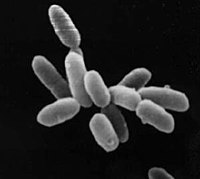Halobacteria
| Halobacteria | |
|---|---|

| |
| Halobacterium sp. strain NRC-1, each cell about 5 µm in length. | |
| Scientific classification | |
| Domain: | |
| Phylum: | |
| Class: | |
| Order | |
| Synonyms | |
| |
- Note: The word "halobacteria" is also the plural form of the word "halobacterium". Halobacteria are more correctly called Haloarchaea, but halobacteria remains in common usage as they were originally designated as such before the existence of the domain Archaea was realised.
In taxonomy, the Halobacteria (also Halomebacteria) are a class of the Euryarchaeota,[1] found in water saturated or nearly saturated with salt. They are also called halophiles, though this name is also used for other organisms which live in somewhat less concentrated salt water. They are common in most environments where large amounts of salt, moisture, and organic material are available.
Halobacteria can grow aerobically, anaerobically, or by means of photosynthesis. Parts of the membranes of halobacteria are purplish in color, and large blooms of Halobacteria appear reddish, from the pigment bacteriorhodopsin, related to the retinal pigment rhodopsin. This pigment is used to absorb light, which provides energy to create ATP. Halobacteria also possess a second pigment, halorhodopsin, which pumps chloride ions in the cell in response to photons, creating a voltage gradient and assisting in the production of energy from light. The process is unrelated to other forms of photosynthesis involving electron transport however, and halobacteria are incapable of fixing carbon from carbon dioxide.
References
- ^ See the NCBI webpage on Halobacteria. Data extracted from the "NCBI taxonomy resources". National Center for Biotechnology Information. Retrieved 2007-03-19.
Further reading
Scientific journals
- Cavalier-Smith, T (2002). "The neomuran origin of archaebacteria, the negibacterial root of the universal tree and bacterial megaclassification". Int. J. Syst. Evol. Microbiol. 52: 7–76. PMID 11837318.
- Woese, CR (1990). "Towards a natural system of organisms: proposal for the domains Archaea, Bacteria, and Eucarya". Proc. Natl. Acad. Sci. USA. 87: 4576–4579. doi:10.1073/pnas.87.12.4576. PMID 2112744.
{{cite journal}}: Unknown parameter|coauthors=ignored (|author=suggested) (help) - Cavalier-Smith, T (1986). "The kingdoms of organisms". Nature. 324: 416–417. doi:10.1038/324416a0. PMID 2431320.
Scientific books
- Grant WD, Kamekura M, McGenity TJ, Ventosa A (2001). "Class III. Halobacteria class. nov.". In DR Boone and RW Castenholz, eds. (ed.). Bergey's Manual of Systematic Bacteriology Volume 1: The Archaea and the deeply branching and phototrophic Bacteria (2nd ed. ed.). New York: Springer Verlag. pp. p. 169. ISBN 978-0387987712.
{{cite book}}:|edition=has extra text (help);|editor=has generic name (help);|pages=has extra text (help)CS1 maint: multiple names: authors list (link) - Garrity GM, Holt JG (2001). "Phylum AII. Euryarchaeota phy. nov.". In DR Boone and RW Castenholz, eds. (ed.). Bergey's Manual of Systematic Bacteriology Volume 1: The Archaea and the deeply branching and phototrophic Bacteria (2nd ed. ed.). New York: Springer Verlag. pp. p. 169. ISBN 978-0387987712.
{{cite book}}:|edition=has extra text (help);|editor=has generic name (help);|pages=has extra text (help)
